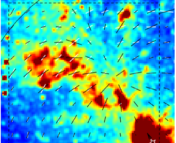Title: The detection of polarized x-ray emission from the magnetar 1E 2259+586
Authors: Jeremy Heyl, Roberto Taverna, Roberto Turolla et al.
First Author’s Institution: University of British Columbia, Vancouver
Status: Published in Monthly Notices of the Royal Astronomical Society
Imagine being a magnetar. Your magnetic field is the strongest found anywhere in the universe, and can rip apart matter at the atomic level. Your very weight warps reality. You can create bursts of gamma rays that will sterilize nearby solar systems.
And yet, you will forever only be the second most powerful of the celestial bodies. You will forever be in thrall to masters of the weakest force in the Universe, even though you possess mastery over the second strongest. And you will never be as well known, as referenced in pop culture, or have as much merchandise made in your image as the beasts who strike fear in your heart.
Of course, you likely wouldn’t care about your popularity on the interstellar backwater known as “Earth.” But just to make you feel better, for today’s paper the spotlight is on you.
Light is A Surprisingly Weighty Topic
Quantum electrodynamics (QED) is our current best theory of how the electromagnetic force works, and has been called the most successful scientific theory of all time for its many predictions with high precision and accuracy. However, there is one prediction of QED that is impossible to test on Earth, and that is vacuum birefringence. Birefringence occurs when a material has a different refractive index for different polarizations of light, and is well known for creating double refraction where the incoming light splits into two paths. In QED, the vacuum itself can act as a birefringent refractor in the presence of strong magnetic fields, splitting a beam of light into two: one beam with a polarization aligned with the magnetic field (the ordinary, or O mode), and the other with a polarization perpendicular to the magnetic field (the extraordinary, or X mode). The required magnetic field strength is too strong to be created by human magnets, but magnetars can generate the necessary strength. As a result, it is expected that the electrical field vector of the X-ray photons emitted by magnetars will always be either parallel or perpendicular to the projection of their magnetic axis onto the plane of the sky. This means that a measurement of the X-ray polarization of magnetars could provide evidence for vacuum birefringence.
…Enter the Imaging X-ray Polarimetry Explorer, or IXPE!
IXPE is the first X-ray telescope capable of measuring the X-ray polarization of a wide range of astronomical objects. The author’s of today’s paper use IXPE to investigate the magnetar 1E 2229+586. It is a rather weakly magnetized magnetar compared to the average population, with a large-scale dipolar magnetic field of only (“only”) about 1013 Gauss. However it exhibits X-ray outbursts that probably mean it has smaller patches of more intense magnetic field (1014-1015 Gauss). It also shows pulses in the X-rays, making it an X-ray pulsar. Two pulses are shown in the top panel of Figure 1.

The second and third panels show the polarization degree and polarization angle as measured during different phases of the magnetar’s rotation about its axis. The polarization degree is the percentage of light that is polarized, while the polarization angle is the angle of the light’s electric field vector measured counterclockwise relative to the North. When the X-rays are initially released from the magnetar’s surface, there are nearly equal amounts of X and O photons, so the net polarization is low (around 10%), with O mode photons predominating at first. The solid orange line in the third panel is a fit to the polarization angle change with phase as predicted by QED . This model fits the data well, and is evidence for this long-untested prediction of QED. However, the authors achieved an even better fit to the data by accounting for the polarization switching modes during each rotation from the magnetar. This fit is shown with a dashed orange line in the third panel.
Arcing into the (Star)set
What could cause the polarization to swap between the ordinary and extraordinary modes? One possibility is the presence of plasma suspended in an arch of the magnetar’s magnetic field. The protons in this plasma circle around the magnetic field in cyclotron motion. When X-rays photons hit them, they will absorb the photons and go into a higher energy level orbit around the magnetic field, then reradiate photons in a different direction, scattering the light. But ordinary mode photons are less likely to scatter than extraordinary mode photons. The net effect is that looking through the plasma, we will see predominantly ordinary mode photons, as the extraordinary photons get scattered out of the line of sight. Conversely, when looking off to the side of the plasma, we will see predominantly extraordinary mode photons, as these are the ones that are being scattered out of the plasma.
Evidence for this possibility can be found in the phase-averaged spectrum, shown in the last panel of Figure 1. There is a prominent dark patch of low relative flux levels during the deepest dip in the pulse profile, marking the location of an absorption line. This absorption line is a cyclotron resonance line, as would occur when the protons orbiting in a plasma loop would absorb the X-rays. Note that the polarization degree during this phase interval is also the highest. This could be explained by the cyclotron scattering filtering out the extraordinary mode photons, leaving mostly ordinary mode photons to reach our detectors. Normally, both extraordinary and ordinary mode photons would be observed, diluting the total polarization.
Altogether these results suggest a magnetic field that is more complex than a simple dipole, with loops and arches of magnetic field fluttering out from the magnetar’s surface. A video of how an arc of magnetized plasma would create the absorption line seen is shown in Figure 2. As quaint as it is, this is but a tease towards understanding the full structure of a magnetar’s magnetic field.
One could only imagine what it would be like to see up close. Tortured whorls of fire and ropes of flux all webbed together, reconnecting as rivers of electricity jolt outwards. What I would give to dive under the ruffling arches of field, soaring over the adamantine crust. Alas, it is a view we could only witness once. Perhaps it is best to stay in our little backwater, and admire from a comfortable distance.
Disclaimer: The joke of a neutron star being super powerful but still only the second-most powerful celestial body came from a comment under a YouTube video about neutron stars. Unfortunately the comment appears to have been deleted, and I cannot find it.
Disclaimer: I am a member of the IXPE collaboration, and while I have not worked on this paper, I currently work with some of the coauthors.
Astrobite edited by Evan Lewis
Featured image credit: Lynnie Saade




